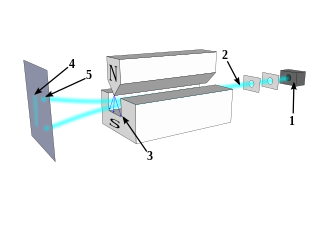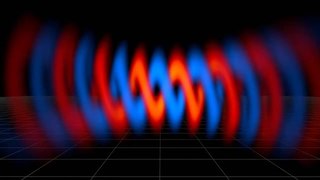Related Research Articles

Deuterium (hydrogen-2, symbol 2H or D, also known as heavy hydrogen) is one of two stable isotopes of hydrogen (the other is protium, or hydrogen-1). The deuterium nucleus, called a deuteron, contains one proton and one neutron, whereas the far more common protium has no neutrons in the nucleus. Deuterium has a natural abundance in Earth's oceans of about one atom of deuterium among every 6,420 atoms of hydrogen (see heavy water). Thus deuterium accounts for about 0.0156% by number (0.0312% by mass) of all hydrogen in the oceans: 4.85×1013 tonnes of deuterium – mainly in form of HOD (or 1HO2H or 1H2HO) and only rarely in form of D2O (or 2H2O) – in 1.4×1018 tonnes of water. The abundance of deuterium changes slightly from one kind of natural water to another (see Vienna Standard Mean Ocean Water).

In nuclear physics, atomic physics, and nuclear chemistry, the nuclear shell model utilizes the Pauli exclusion principle to model the structure of atomic nuclei in terms of energy levels. The first shell model was proposed by Dmitri Ivanenko in 1932. The model was developed in 1949 following independent work by several physicists, most notably Maria Goeppert Mayer and J. Hans D. Jensen, who received the 1963 Nobel Prize in Physics for their contributions to this model, and Eugene Wigner, who received the Nobel Prize alongside them for his earlier groundlaying work on the atomic nuclei.
This is a timeline of quantum computing.

In quantum physics and chemistry, quantum numbers are quantities that characterize the possible states of the system. Quantum numbers are closely related to eigenvalues of observables. When the corresponding observable commutes with the Hamiltonian, the quantum number is said to be "good", and acts as a constant of motion in the quantum dynamics.

In quantum physics, the Stern–Gerlach experiment demonstrated that the spatial orientation of angular momentum is quantized. Thus an atomic-scale system was shown to have intrinsically quantum properties. In the original experiment, silver atoms were sent through a spatially-varying magnetic field, which deflected them before they struck a detector screen, such as a glass slide. Particles with non-zero magnetic moment were deflected, owing to the magnetic field gradient, from a straight path. The screen revealed discrete points of accumulation, rather than a continuous distribution, owing to their quantized spin. Historically, this experiment was decisive in convincing physicists of the reality of angular-momentum quantization in all atomic-scale systems.
In physics and chemistry, the spin quantum number is a quantum number that describes the intrinsic angular momentum of an electron or other particle. It has the same value for all particles of the same type, such as s = 1/2 for all electrons. It is an integer for all bosons, such as photons, and a half-odd-integer for all fermions, such as electrons and protons.
In physics, Larmor precession is the precession of the magnetic moment of an object about an external magnetic field. The phenomenon is conceptually similar to the precession of a tilted classical gyroscope in an external torque-exerting gravitational field. Objects with a magnetic moment also have angular momentum and effective internal electric current proportional to their angular momentum; these include electrons, protons, other fermions, many atomic and nuclear systems, as well as classical macroscopic systems. The external magnetic field exerts a torque on the magnetic moment,

An optical vortex is a zero of an optical field; a point of zero intensity. The term is also used to describe a beam of light that has such a zero in it. The study of these phenomena is known as singular optics.

Nuclear magnetic resonance quantum computing (NMRQC) is one of the several proposed approaches for constructing a quantum computer, that uses the spin states of nuclei within molecules as qubits. The quantum states are probed through the nuclear magnetic resonances, allowing the system to be implemented as a variation of nuclear magnetic resonance spectroscopy. NMR differs from other implementations of quantum computers in that it uses an ensemble of systems, in this case molecules, rather than a single pure state.
A g-factor is a dimensionless quantity that characterizes the magnetic moment and angular momentum of an atom, a particle or the nucleus. It is essentially a proportionality constant that relates the different observed magnetic moments μ of a particle to their angular momentum quantum numbers and a unit of magnetic moment, usually the Bohr magneton or nuclear magneton. Its value is proportional to the gyromagnetic ratio.
Spin is an intrinsic form of angular momentum carried by elementary particles, and thus by composite particles such as hadrons, atomic nuclei, and atoms. Spin is quantized, and accurate models for the interaction with spin require relativistic quantum mechanics or quantum field theory.

Nuclear magnetic resonance (NMR) is a physical phenomenon in which nuclei in a strong constant magnetic field are perturbed by a weak oscillating magnetic field and respond by producing an electromagnetic signal with a frequency characteristic of the magnetic field at the nucleus. This process occurs near resonance, when the oscillation frequency matches the intrinsic frequency of the nuclei, which depends on the strength of the static magnetic field, the chemical environment, and the magnetic properties of the isotope involved; in practical applications with static magnetic fields up to ca. 20 tesla, the frequency is similar to VHF and UHF television broadcasts (60–1000 MHz). NMR results from specific magnetic properties of certain atomic nuclei. Nuclear magnetic resonance spectroscopy is widely used to determine the structure of organic molecules in solution and study molecular physics and crystals as well as non-crystalline materials. NMR is also routinely used in advanced medical imaging techniques, such as in magnetic resonance imaging (MRI). The original application of NMR to condensed matter physics is nowadays mostly devoted to strongly correlated electron systems. It reveals large many-body couplings by fast broadband detection and it should not to be confused with solid state NMR, which aims at removing the effect of the same couplings by Magic Angle Spinning techniques.

The angular momentum of light is a vector quantity that expresses the amount of dynamical rotation present in the electromagnetic field of the light. While traveling approximately in a straight line, a beam of light can also be rotating around its own axis. This rotation, while not visible to the naked eye, can be revealed by the interaction of the light beam with matter.

The orbital angular momentum of light (OAM) is the component of angular momentum of a light beam that is dependent on the field spatial distribution, and not on the polarization. OAM can be split into two types. The internal OAM is an origin-independent angular momentum of a light beam that can be associated with a helical or twisted wavefront. The external OAM is the origin-dependent angular momentum that can be obtained as cross product of the light beam position and its total linear momentum.

Orbital angular momentum multiplexing is a physical layer method for multiplexing signals carried on electromagnetic waves using the orbital angular momentum (OAM) of the electromagnetic waves to distinguish between the different orthogonal signals.

Miles John Padgett is a Royal Society Research Professor of Optics in the School of Physics and Astronomy at the University of Glasgow. He has held the Kelvin Chair of Natural Philosophy since 2011 and served as Vice Principal for research at Glasgow from 2014 to 2020.
The DiVincenzo criteria are conditions necessary for constructing a quantum computer, conditions proposed in 2000 by the theoretical physicist David P. DiVincenzo, as being those necessary to construct such a computer—a computer first proposed by mathematician Yuri Manin, in 1980, and physicist Richard Feynman, in 1982—as a means to efficiently simulate quantum systems, such as in solving the quantum many-body problem.

Electrons in free space can carry quantized orbital angular momentum (OAM) projected along the direction of propagation. This orbital angular momentum corresponds to helical wavefronts, or, equivalently, a phase proportional to the azimuthal angle. Electron beams with quantized orbital angular momentum are also called electron vortex beams.
In quantum computing, quantum memory is the quantum-mechanical version of ordinary computer memory. Whereas ordinary memory stores information as binary states, quantum memory stores a quantum state for later retrieval. These states hold useful computational information known as qubits. Unlike the classical memory of everyday computers, the states stored in quantum memory can be in a quantum superposition, giving much more practical flexibility in quantum algorithms than classical information storage.
The nucleon magnetic moments are the intrinsic magnetic dipole moments of the proton and neutron, symbols μp and μn. The nucleus of an atom comprises protons and neutrons, both nucleons that behave as small magnets. Their magnetic strengths are measured by their magnetic moments. The nucleons interact with normal matter through either the nuclear force or their magnetic moments, with the charged proton also interacting by the Coulomb force.
References
- 1 2 3 Faculty profile Archived 2021-09-13 at the Wayback Machine , University of Waterloo, retrieved 2014-07-16.
- 1 2 David Cory, Canada Excellence Research Chairs, Government of Canada, accessed 2014-07-16.
- ↑ "Alum Updates" (PDF), The Case Chemist, 104: 7, Winter 2010–2011.
- ↑ Cory, David G. (1987). Applications of cross polarization spin dynamics in solids (Thesis). Case Western Reserve University. OCLC 16259096.
- ↑ Lloyd, Seth (2006), Programming the Universe: A Quantum Computer Scientist Takes on the Cosmos, Alfred A. Knopf, pp. 151–152, ISBN 978-0-307-26471-8 .
- ↑ Science News Staff (17 January 1997), "Quantum Computer in a Cup of Joe?", Science, doi: 10.1126/article.40628 (inactive 31 January 2024)
{{citation}}: CS1 maint: DOI inactive as of January 2024 (link) - ↑ "Quantum dreams", The Economist , March 8, 2001.
- ↑ Cory, David G.; Fahmy, Amr F.; Havel, Timothy F. (1997-03-04). "Ensemble quantum computing by NMR spectroscopy". Proceedings of the National Academy of Sciences. 94 (5): 1634–1639. Bibcode:1997PNAS...94.1634C. doi: 10.1073/pnas.94.5.1634 . ISSN 0027-8424. PMC 19968 . PMID 9050830.
- ↑ "MIT researchers create quantum computer that simulates quantum system", MIT News, June 25, 1999
- ↑ Clark, Charles W.; Barankov, Roman; Huber, Michael G.; Arif, Muhammad; Cory, David G.; Pushin, Dmitry A. (2015-09-23). "Controlling neutron orbital angular momentum". Nature. 525 (7570): 504–506. Bibcode:2015Natur.525..504C. doi:10.1038/nature15265. ISSN 0028-0836. PMID 26399831. S2CID 4454300.
- ↑ Sarenac, D; Nsofini, J; Hincks, I; Arif, M; Clark, Charles W; Cory, D G; Huber, M G; Pushin, D A (2018-10-10). "Methods for preparation and detection of neutron spin-orbit states". New Journal of Physics. 20 (10): 103012. arXiv: 1803.02295 . Bibcode:2018NJPh...20j3012S. doi:10.1088/1367-2630/aae3ac. ISSN 1367-2630. PMC 8634251 . PMID 34858077.
- ↑ Sarenac, Dusan; Kapahi, Connor; Chen, Wangchun; Clark, Charles W.; Cory, David G.; Huber, Michael G.; Taminiau, Ivar; Zhernenkov, Kirill; Pushin, Dmitry A. (2019-10-08). "Generation and detection of spin-orbit coupled neutron beams". Proceedings of the National Academy of Sciences. 116 (41): 20328–20332. arXiv: 1904.09520 . Bibcode:2019PNAS..11620328S. doi: 10.1073/pnas.1906861116 . ISSN 0027-8424. PMC 6789912 . PMID 31548384.